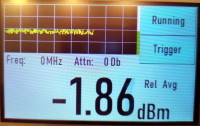2 Channel RF power meter with Wifi, Bluetooth, SD card and touch screen

2 Channel power meter up to 10GHz with 92dB dynamic range. Lots of measurement functions. Compatible with almost all power detector chips.
Next version of my previous RF Power meter
https://www.elektormagazine.com/labs/rf-power-meter-with-1mhz-10ghz-bandwidth-and-55db-dynamic-range
Features
https://www.elektormagazine.com/labs/rf-power-meter-with-1mhz-10ghz-bandwidth-and-55db-dynamic-range
Features
- 2 Channels
- Up to 10 GHz range
- Up to 92 dB dynamic range
- Swappable 4 layer RF breakout boards for AD83xx, LT5537, LMV22x, LT8881, etc.
- Compatible with Elector RF Breakout module (160193-91)
- 250 ksps 16 bit ADC per channel
- ESP32 WROVER 16MB Flash, 8MB RAM
- 3.5" LCD with touch screen
- SD Card support
- Wifi
- Bluetooth
- USB
- Realtime clock
- Sync RTC with NTP server
- HTML interface
- Downloading measurement data to PC
- SWR measurement
- Trigger input
- Scope display
- Trigger modes: normal, single, auto
- Data logging to memory and SD Card
- Measurements: Min, Max, Average, modulation depth, statistics, etc.
- Encoder with button
- Low noise power supplies
- SCPI commands



Updates from the author